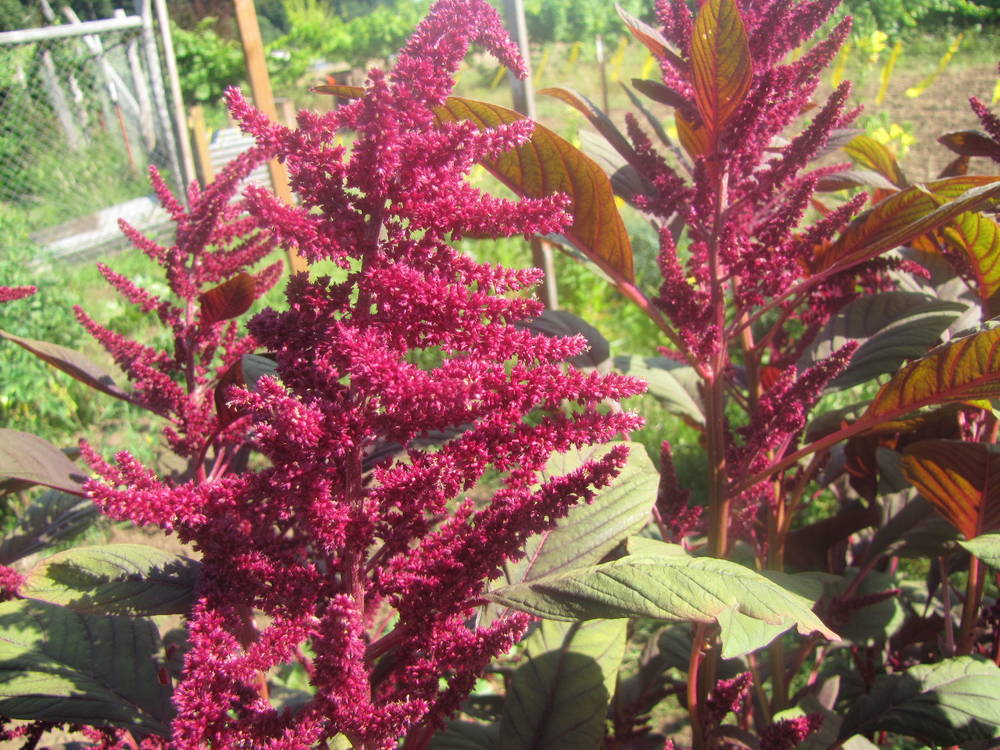Amaranthus hybridus
Amaranthus
slender pigweed, slim amaranth
amaranth
erect, branched or not, 3–12(20) dm, green or red.
prostrate to erect, branched, occasionally simple.
blades rhombic-ovate to widely lanceolate; (2)4–12(15) cm, bases wedge-shaped;
margins entire; plane;
tips acute to obtuse;
midveins extending to a spine;
petioles 1–5(10) cm.
alternate;
blades ovate to linear; flat;
midveins extending to short spine or awn at tip;
margins entire; flat or crisped;
tips acute, obtuse or rounded;
petioles present.
terminal and axillary, tightly clustered; lax and nodding; dull green to red, villous;
bracts 2–4 mm;
midveins extending to a spine.
terminal and axillary spikes or panicles with flowers densely clustered, or rarely axillary with solitary flowers;
bracts leaf-like, often spine-tipped.
perianth segments 5, mostly similar in staminate and pistillate flowers; erect, not overlapping or reflexed, linear to lance-oblong;
midveins extending to spine;
tips acute.
unisexual, staminate and pistillate flowers typically distinct;
perianth segments membranous or scarious.
generally at inflorescence tips;
perianth segments of nearly equal length, 2–3 mm;
stamens 5.
perianth segments (2)3–5, scarious;
stamens (1)2–5;
filaments free.
perianth segments of equal length or 1 slightly longer, 1.5–2 mm;
styles 3; erect.
perianth segments (1)3–5;
ovules 1;
styles 0;
stigmas 2–3, persistent.
ovoid, 1.5–2.2 mm, rugose at tips; smooth below; dehiscence circumscissile.
utricles; ovoid to obovoid, usually smooth;
walls thin and membranous.
lenticular, widely orbicular to rounded, 1–1.4 mm, red-brown to black; shiny.
lenticular to ± spherical, usually dark reddish brown to black; smooth; shiny.
=32.
Amaranthus hybridus
Amaranthus
Disturbed areas, streambanks, roadsides, fields. Flowering May–Oct. 0–700 m. Casc, Owy, Sisk, WV. CA, ID, NV, WA; throughout North America; scattered worldwide. Native?
Amaranthus hybridus has been known to hybridize with A. retroflexus.
Worldwide. ~70 species; 6 species treated in Flora.
Amaranthus species have long been cultivated as cereal grains and ornamentals. Several cultivated and exotic species are known as short-lived waifs in Oregon: A. deflexus, A. hypochondriacus, and A. viridus.
Bridget Chipman
Bridget Chipman
- Local floras:
CA,
OR,
WA
- Local Web sites:
CalFlora,
CalPhotos,
Flora NW,
PNW Herbaria
WildflowerSearch
iNaturalist (observations)
USDA Plants Database
- LBJ Wildflower Center
- SEINet
- Plants of the World Online
- Encyclopedia of Life
- Wikipedia
- Google Image Search
- Local floras:
CA,
OR,
WA
- Local Web sites:
CalFlora,
CalPhotos,
Flora NW,
PNW Herbaria
WildflowerSearch
iNaturalist (observations)
USDA Plants Database
- LBJ Wildflower Center
- SEINet
- Plants of the World Online
- Encyclopedia of Life
- Wikipedia
- Google Image Search



